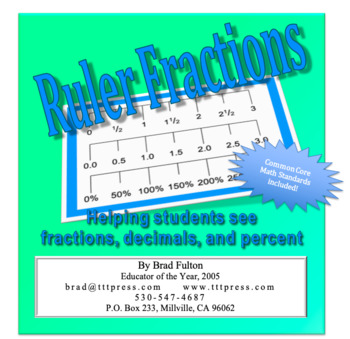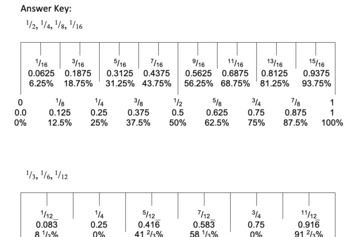Ruler Fractions: Helping Students See Fractions, Decimals, and Percent
Teacher to Teacher Press
482 Followers
Teacher to Teacher Press
482 Followers
Description
This activity allows students to see the relationships between fractions, decimals, and percents. It accomplishes this by using a visual model and fractions of halves, fourths and eighths. These denominators are more understandable to beginning students. This eases them into the lesson. Then they progress to thirds, fifths, sixths, tenths, and twelfths later. Part whole concepts are presented concurrently as fractions, decimals, and percent representations.
Total Pages
12 pages
Answer Key
N/A
Teaching Duration
2 days
Last updated Jan 13th, 2019
Report this resource to TPT
Reported resources will be reviewed by our team. Report this resource to let us know if this resource violates TPT’s content guidelines.
Standards
to see state-specific standards (only available in the US).
CCSS3.MD.B.4
Generate measurement data by measuring lengths using rulers marked with halves and fourths of an inch. Show the data by making a line plot, where the horizontal scale is marked off in appropriate units-whole numbers, halves, or quarters.
CCSS4.MD.A.1
Know relative sizes of measurement units within one system of units including km, m, cm; kg, g; lb, oz.; l, ml; hr, min, sec. Within a single system of measurement, express measurements in a larger unit in terms of a smaller unit. Record measurement equivalents in a two-column table. For example, know that 1 ft is 12 times as long as 1 in. Express the length of a 4 ft snake as 48 in. Generate a conversion table for feet and inches listing the number pairs (1, 12), (2, 24), (3, 36),...
CCSS5.MD.A.1
Convert among different-sized standard measurement units within a given measurement system (e.g., convert 5 cm to 0.05 m), and use these conversions in solving multi-step, real world problems.
CCSS5.NBT.A.3a
Read and write decimals to thousandths using base-ten numerals, number names, and expanded form, e.g., 347.392 = 3 × 100 + 4 × 10 + 7 × 1 + 3 × (1/10) + 9 × (1/100) + 2 × (1/1000).
CCSS5.NBT.A.3b
Compare two decimals to thousandths based on meanings of the digits in each place, using >, =, and < symbols to record the results of comparisons.





